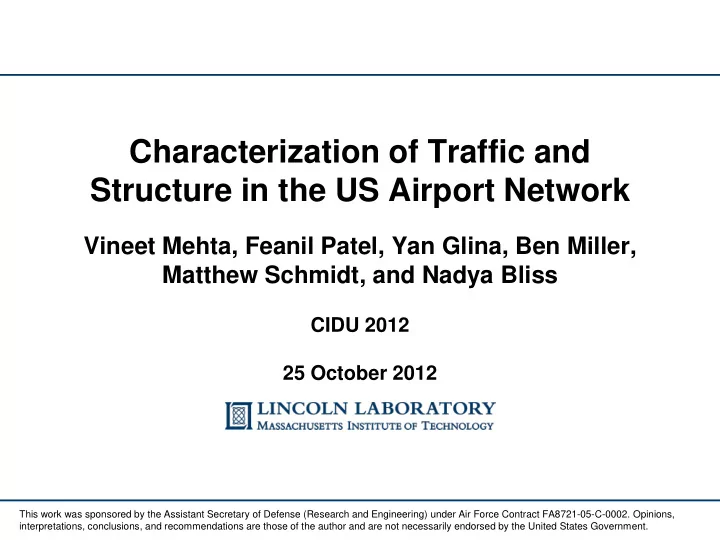

Characterization of Traffic and Structure in the US Airport Network Vineet Mehta, Feanil Patel, Yan Glina, Ben Miller, Matthew Schmidt, and Nadya Bliss CIDU 2012 25 October 2012 This work was sponsored by the Assistant Secretary of Defense (Research and Engineering) under Air Force Contract FA8721-05-C-0002. Opinions, interpretations, conclusions, and recommendations are those of the author and are not necessarily endorsed by the United States Government.
Motivation • Applications: – management/planning of air traffic system, impact of air traffic emissions on environment, connection with economic activity, vulnerabilities... • Prior modeling efforts: – Aggregate models of traffic time dynamics (e.g. 20 CONUS centers) – Structural analysis of aggregate properties (week – years) airport networks • Current work: – Re-examination of aggregate properties – Analysis of temporal characteristics of US airport network – Employing data provided by the FAA Traffic Flow Management System, via the Aircraft Situational Display to Industry data stream Presentation Name - 2 Author Initials MM/DD/YY
Analysis & Modeling Approach • Analysis of undirected weighted graphs • Structural characteristics – degree/weight distributions – clustering coefficient – vertex strength • Temporal characteristics – aggregate metrics: flight count, edge count – n-lag difference graphs – correlation • Spectral analysis Presentation Name - 3 Author Initials MM/DD/YY
Structural Characteristics Degree Distribution Vertex strength Edge weight histogram • Power law vertex degree distribution – “scale - free” property – Hub-spoke topology also a characteristic of other airport networks • Exponential relation between vertex strength and degree – Higher degree airports carry higher than average traffic Structural characteristics consistent with findings of previous studies Presentation Name - 4 Author Initials MM/DD/YY
Structural Characteristics (Clustering Coefficient) • Previous studies have found low degree airports to exhibit a high degree of interconnect • To the “contrary”, this analysis has found the local clustering coefficient to be low, and appears uniform with degree • Clustering coefficient for intersection graph is similar to previous studies – Previous studies possibly limited to using scheduled flight data Presentation Name - 5 Author Initials MM/DD/YY
Temporal Characteristics (Aggregate Properties) Daily Flight Count Daily Edge Count • Flight and edge counts exhibit week-duration periodicity • However, the aggregate edge count masks more complex underlying dynamics Presentation Name - 6 Author Initials MM/DD/YY
Temporal Characteristics (Difference Graph Properties) 1-day Lag Edge Counts 7-day Lag Edge Counts • Uncommon edge counts between adjacent days same order as daily edge counts – A significant portion of traffic from one day to next is between new airport pairs • Weekly periodic trend is removable by 7-day lag intersection – A significant portion of traffic does NOT follow a weekly trend Presentation Name - 7 Author Initials MM/DD/YY
Temporal Characteristics (Time Correlation) • Correlation of edge time series • Plot shows: – Average, standard deviation, and maximum correlations Max • Aggregate or maximum value Std. Dev Mean suggest a high degree of correlation between days • However underlying edge dynamics are in fact NOT well correlated Presentation Name - 8 Author Initials MM/DD/YY
Spectral Analysis Eigenvalue Spectrum • Eigenvalue spectrum shows power law decay • High degree of correlation in leading eigenvectors • Suggests low rank models are feasible for time series prediction Spectral Model Residual Power Eigenvector Correlation Presentation Name - 9 Author Initials MM/DD/YY
Conclusions • Network analysis of inter- city traffic using FAA’s traffic flow management data stream • Found daily graph clustering properties to differ from previously reported results (due to limits of those data sets) • Quantified temporally complex behavior, which contains a significant non-weekly trend • Spectral analysis: – Dominant eigenvectors are quasi-stationary – Low rank spectral models capture bulk of daily network power – Preliminary analysis suggests utility of model in forecasting Presentation Name - 10 Author Initials MM/DD/YY
Recommend
More recommend